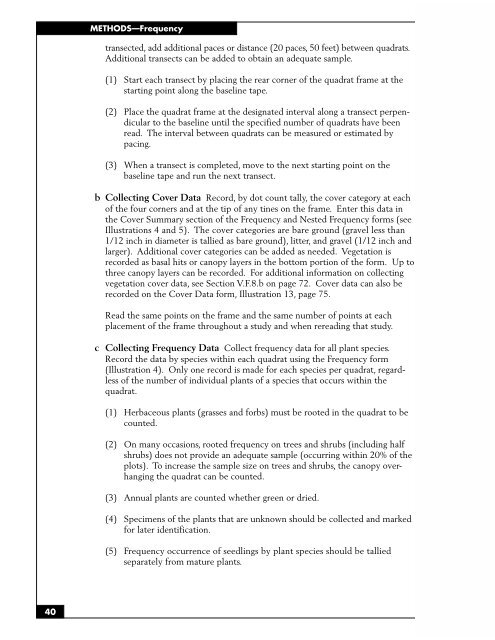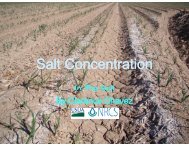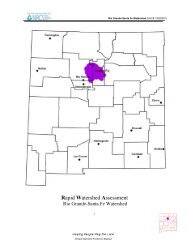SAMPLING VEGETATION ATTRIBUTES - New Mexico NRCS - US ...
SAMPLING VEGETATION ATTRIBUTES - New Mexico NRCS - US ...
SAMPLING VEGETATION ATTRIBUTES - New Mexico NRCS - US ...
Create successful ePaper yourself
Turn your PDF publications into a flip-book with our unique Google optimized e-Paper software.
40<br />
METHODS—Frequency<br />
transected, add additional paces or distance (20 paces, 50 feet) between quadrats.<br />
Additional transects can be added to obtain an adequate sample.<br />
(1) Start each transect by placing the rear corner of the quadrat frame at the<br />
starting point along the baseline tape.<br />
(2) Place the quadrat frame at the designated interval along a transect perpendicular<br />
to the baseline until the specified number of quadrats have been<br />
read. The interval between quadrats can be measured or estimated by<br />
pacing.<br />
(3) When a transect is completed, move to the next starting point on the<br />
baseline tape and run the next transect.<br />
b Collecting Cover Data Record, by dot count tally, the cover category at each<br />
of the four corners and at the tip of any tines on the frame. Enter this data in<br />
the Cover Summary section of the Frequency and Nested Frequency forms (see<br />
Illustrations 4 and 5). The cover categories are bare ground (gravel less than<br />
1/12 inch in diameter is tallied as bare ground), litter, and gravel (1/12 inch and<br />
larger). Additional cover categories can be added as needed. Vegetation is<br />
recorded as basal hits or canopy layers in the bottom portion of the form. Up to<br />
three canopy layers can be recorded. For additional information on collecting<br />
vegetation cover data, see Section V.F.8.b on page 72. Cover data can also be<br />
recorded on the Cover Data form, Illustration 13, page 75.<br />
Read the same points on the frame and the same number of points at each<br />
placement of the frame throughout a study and when rereading that study.<br />
c Collecting Frequency Data Collect frequency data for all plant species.<br />
Record the data by species within each quadrat using the Frequency form<br />
(Illustration 4). Only one record is made for each species per quadrat, regardless<br />
of the number of individual plants of a species that occurs within the<br />
quadrat.<br />
(1) Herbaceous plants (grasses and forbs) must be rooted in the quadrat to be<br />
counted.<br />
(2) On many occasions, rooted frequency on trees and shrubs (including half<br />
shrubs) does not provide an adequate sample (occurring within 20% of the<br />
plots). To increase the sample size on trees and shrubs, the canopy overhanging<br />
the quadrat can be counted.<br />
(3) Annual plants are counted whether green or dried.<br />
(4) Specimens of the plants that are unknown should be collected and marked<br />
for later identification.<br />
(5) Frequency occurrence of seedlings by plant species should be tallied<br />
separately from mature plants.




